My Home Cell Booster Install
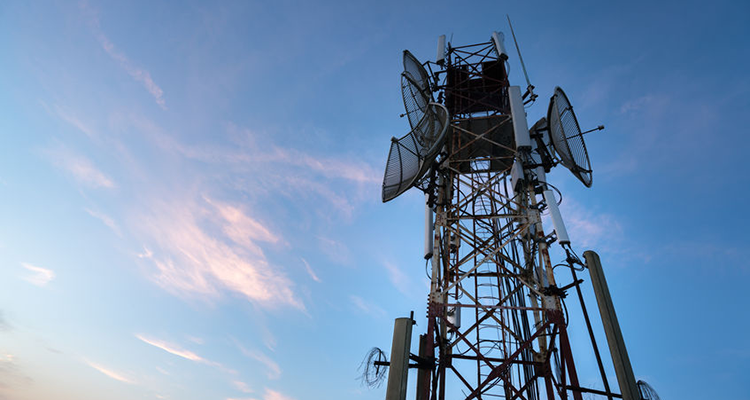 One of my favorite aphorisms says that “every solution has two problems.” This understanding applies to all things.
One of my favorite aphorisms says that “every solution has two problems.” This understanding applies to all things.
We moved into a new home in a new neighborhood. It’s right on the edge of the city. At least for now, until the fields south of here get developed too.
A consequence of this being a brand new neighborhood is that the cellphone reception is terrible, almost nonexistent.
There are two primary reasons for that. The first is that the nearest tower our carrier TELUS has is quite far away, northwest of our location. The other is that because of all the new development south of that cell tower, the total load on it from the mobile devices of all the people living in his area are too much for it.
The result is a weak signal and lots of dropped calls.
In our new house, we literally had one bar on our phones, if we were lucky.
Eventually, TELUS will address this and put a new tower to take the strain off the other one. But the keyword here is “eventually.” Because both my wife and I depend on our cellphones for our work, we needed an immediate solution.
Fortunately, I know a guy. Cell signal boosters are one of the categories the company I work for distributes to installing dealers, so I have a connection, no pun intended.
Reaching out to my counterpart, the national manager for one of our vendors sent me a residential in-building booster. He did ask me in return to do a write-up on the process, so here we are.
If you don’t already know, cell signal boosters are a category of product available for in-vehicle or in-building applications. They’re an amplifier: They take weak cell signals and amplify them enough for your phone to be able to make a strong connection, both the uplink and the downlink.
Signal strength is obviously important for voice, but it’s even more important for data: the stronger the signal, the faster your device’s uploads and downloads will be.
In practice, installing a cell booster into a building is not dissimilar to installing a satellite dish, an analogy most AV pros will be familiar with. An external antenna is mounted on the outside of the building, with a line run inside to the amplifier’s location (usually the mechanical room), then a second line is run to the interior antenna, which rebroadcasts the signal from outside.
My vendor contact was kind enough to send me a booster, so that part was solved. Now I needed to get it installed. While I understand the principles of booster installation quite well, and I spend time on the phone advising and troubleshooting for my installing dealers, the fact is that I’m no genius installer. I’m a wire monkey, third class, at best.
My choices were to either spend an undefined amount of time puttering around the task and drilling random holes in the side of my house, or I could hire professionals.
Because I respect expertise, not just mine but other people’s especially, I opted for the latter. I contracted one of my local commercial/industrial installers, Tridon Communications, to do my install.
What follows will be familiar to all the AV pros. It began with a site survey of my house on one day, followed by the installation on the next.
The site survey activities fell into two categories. Tim and Ben, the installers, walked around the house, both inside and out, measuring the signal strength in different areas. Even as seasoned installers they were puzzled by the anomalous readings.
On paper, or rather on the map of cell towers that Loxcel Geomatics maintains for industry pros, it looks simple. Yet the difference between what the map says and the reality what the readings on the signal meters said were very different.
Tim and Ben even hopped in the truck and drove around the neighborhood for a few minutes, taking more readings at different locations.
I’ve already mentioned the issues with the distant TELUS tower, and the heavy load placed on it by new developments. To further confound matters, TELUS isn’t the only mobile provider. There are others. And they all have their own towers. There is a big Rogers tower literally down the block from my house. All the Canadian carriers use the same frequencies, which means that there will be zones where the frequencies from competing towers interfere or cancel each other out.
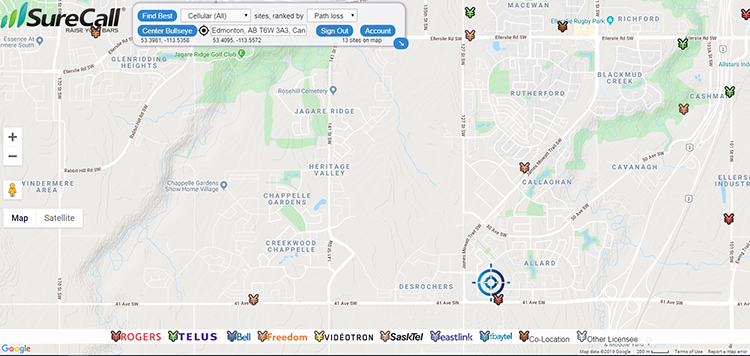 The solution to competing tower signals was a directional YAGI antenna, aimed at the target tower. The alternative to a directional antenna is an omnidirectional antenna, which radiates in a 360-degree arc. There are applications where those are useful, but with a Rogers tower with a stronger signal literally next door, an omnidirectional antenna would lock the booster onto that tower, and we’d get no improvement in cell signal performance.
The solution to competing tower signals was a directional YAGI antenna, aimed at the target tower. The alternative to a directional antenna is an omnidirectional antenna, which radiates in a 360-degree arc. There are applications where those are useful, but with a Rogers tower with a stronger signal literally next door, an omnidirectional antenna would lock the booster onto that tower, and we’d get no improvement in cell signal performance.
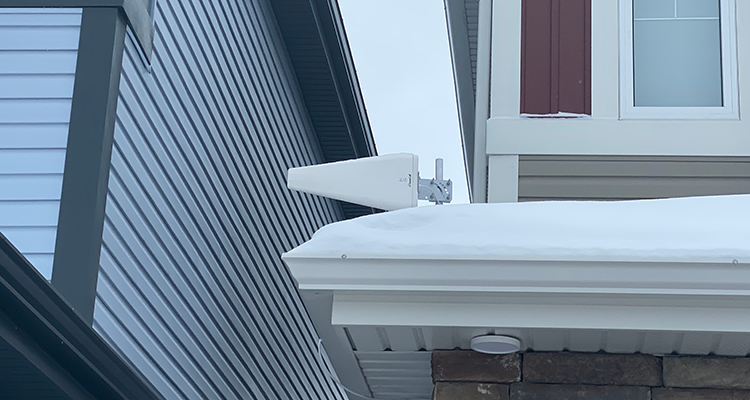 Fortuitously, the outside location with the best signal strength from the target tower was the garage roof, which worked out well for the rest of the install, because it was on the same side of the house that the utilities and the fiber optic enter, so it was a short run from the roof to the house’s inputs into the utility room.
Fortuitously, the outside location with the best signal strength from the target tower was the garage roof, which worked out well for the rest of the install, because it was on the same side of the house that the utilities and the fiber optic enter, so it was a short run from the roof to the house’s inputs into the utility room.
Inside the house, Tim, Ben and I discussed the best location of the interior antenna based on both technical factors as well as the layout of the floorplan, and how we live in it.
On the technical side, it’s necessary to allow enough physical separation, vertically and horizontally, between the two antennae so that they don’t oscillate between them and interfere with each other. On the lifestyle side, we needed maximum signal strength in the office upstairs and main floor living areas.
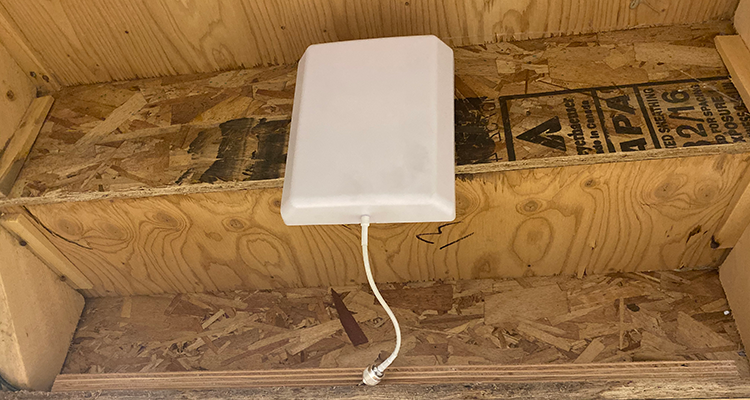 The solution to both was to mount the interior antenna in the ceiling of the stairwell to the basement. That location provides both separation and coverage. The wire run from the booster’s location in the mechanical room was also relatively straightforward across the basement ceiling to the ducts up to the main floor.
The solution to both was to mount the interior antenna in the ceiling of the stairwell to the basement. That location provides both separation and coverage. The wire run from the booster’s location in the mechanical room was also relatively straightforward across the basement ceiling to the ducts up to the main floor.
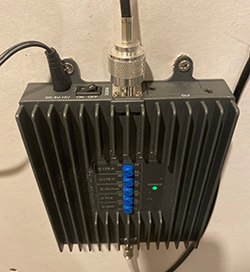 Aesthetically, it also provided concealment. We didn’t have to put up with the wall-wart of a panel antenna visible in the living room. And when we get around to finishing the basement, I can have the drywallers board up the antenna in the stairwell ceiling, with just a porthole door installed in case the antenna ever fails and needs to be replaced.
Aesthetically, it also provided concealment. We didn’t have to put up with the wall-wart of a panel antenna visible in the living room. And when we get around to finishing the basement, I can have the drywallers board up the antenna in the stairwell ceiling, with just a porthole door installed in case the antenna ever fails and needs to be replaced.
Spontaneous antenna failures in the field are rare but they do happen, so that’s why I’m thinking ahead.
The end result was positive. We got dramatically better cell service inside the house, and can now actually make and stay on phone calls.
Retrofit installations in built structures are seldom easy, but this one was fortunately fairly straightforward. Still, I appreciated the expertise and hard work of Tim and Ben from Tridon. They did a better job than I would have on my own.





